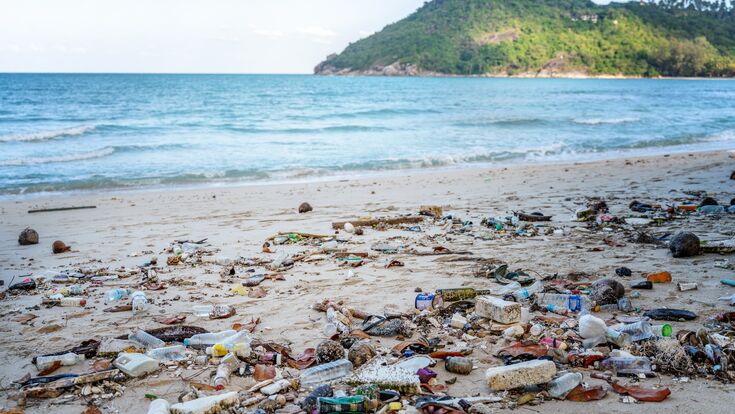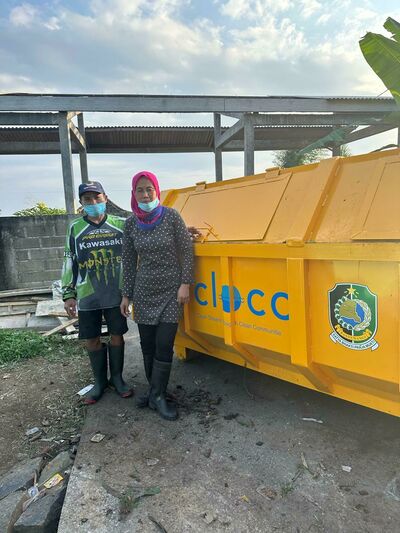Pollution : Fighting marine litter on land

According to the United Nations Environment Programme (UNEP) more than 460 million metric tonnes of plastic are produced each year. An estimated 19 to 23 million tonnes of plastic waste end up in aquatic ecosystems, polluting lakes, rivers and seas. To give a better picture: This means that the equivalent of 2,000 waste trucks full of plastic are dumped into the world's oceans, rivers, and lakes. That amount is expected to increase significantly by 2040. Plastic pollution has major impacts on ecosystems, economies and society – including on human health. Even though it is not only plastic that is responsible for polluting our waters, the fossil fuel-based material is top of the list.
To get to grips with the situation, there are initiatives around the world that focus primarily on improving local conditions. The key reason for marine litter is inadequate waste management on land. Clean Oceans through Clean Communities (CLOCC), a community-driven project, helps communities to set up sustainable waste management systems. Aditi Ramola, Technical Director, International Solid Waste Association (ISWA) and Oda Kristin Korneliussen, Programme Manager CLOCC, Advisor Avfall Norge, talk with Waste Management World about the sources of marine litter, the role of NGOs in combatting it and the achievements of the CLOCC project so far.
What are the primary sources of marine litter?
So we have land-based sources and sea-based sources – both contribute to significant harm to the marine environment.
The majority of the litter we find in the marine environment comes from land-based sources but sea-based sources like fishing gear ‒ discarded or lost nets ‒ constitute a significant portion of marine litter. This gear can continue to capture marine life and damage habitats long after it has been discarded. Of course, tourist or recreational activities also contribute to marine pollution if beaches are not cleaned frequently and items left behind by visitors, such as plastic bottles, bags and food packaging, can contribute significantly to marine pollution. Ships and boats can also contribute to marine litter through accidental spills, improper waste disposal practices and the loss of cargo containers overboard.
Land-based sources of marine litter include but are not limited to, unsound waste management and inadequate waste management practices on land. This includes poorly managed landfills, illegal dumping, and littering. Plastic packaging and small plastic items are particularly problematic, making up nearly 80% of the plastic waste that ends up in the marine environment. Urban areas contribute significantly to marine litter through stormwater systems that carry debris from streets and other urban infrastructure directly into rivers and coastal areas. Additionally, rivers act as conduits, transporting large amounts of waste from inland areas to the sea. Finally, industrial activities on land can lead to the release of plastic pellets, chemicals and other pollutants that eventually make their way into marine environments.
Related article: The Top Plastic Polluters
-
1"The majority of the litter we find in the marine environment comes from land-based sources."
Aditi Ramola, Technical Director ISWA
What types of materials are most commonly found in marine litter?
We carried out an on-the-ground assessment of the most commonly found materials in marine litter in Brazil and saw that cigarette butts and discarded single-use plastics such as plastic bags and single-use plastic cutlery were very common. Other studies have shown that finding discarded, lost or abandoned finishing gear is also common. Other materials like glass, metal, rubber and textiles are also found in smaller quantities. Studies and assessments by the UN and other organisations consistently identify plastic as the dominant material in marine litter, accounting for up to 85% of the total debris found in marine environments. Understanding the types and sources of marine litter is crucial as it helps policymakers and organisations better target their efforts to reduce pollution and protect marine ecosystems.
What are the impacts of plastics compared to other types of litter (e.g. metals, glass, organic waste)?
As mentioned earlier, marine debris is made up of materials such as single-use plastic, glass and rubber fragments, some textiles, fishing gear, metals, etc. The most dominant of these is plastics and this can have a multitude of severe impacts on marine life compared to other materials. Plastics often contain harmful chemicals that are added to enhance their useful properties but when reaching the environment can release harmful chemicals such as BPA or PFAS. Discarded fishing gear mostly made from plastic entangles marine life.
Related article: Trash Boom: A new technology to stop marine littering
What role do governments and NGOs play in combating marine litter?
Both governments and NGOs play a crucial role in efforts towards combatting marine litter. They do so particularly through policy intervention, coordinated actions and last but not least – public engagement. Governments set the enabling and framework conditions through laws and regulations, and NGOs collaborate with government bodies to enhance these efforts, often focusing on capacity building, community education and local clean-up activities.
How can the effectiveness of marine litter regulations be measured?
I don’t think there is an agreement on this yet but some indicators and methodologies can be helpful in measuring the effectiveness of marine litter regulations – for instance these could involve data collection and analysis to evaluate the impact of policies and action. Regular sampling and waste source identification could help in assessing whether quantities are varying over time.
Can you describe the CLOCC project?
The Clean Oceans through Clean Communities (CLOCC) Programme is a community and network-driven programme owned by Avfall Norge and funded by Norad (the Norwegian Agency for Development Cooperation).
What are the project's goals and outcomes?
CLOCC’s vision is to achieve healthy societies and a clean environment ‒ through sustainable communities, green jobs and business opportunities in local circular economies. CLOCC uses a participatory planning process through hybrid training (in person with some online components), conducting stakeholder meetings, baseline assessments and Waste Master Plan development with a focus on governance and stakeholder involvement. CLOCC uses a 7-step integrated sustainable waste management approach for waste management planning and stakeholder engagement process.

What challenges did you face, and how did you address them?
Since CLOCC is a very complex programme, we have faced challenges as we are one of the first to test this methodology. We also work at the systems level, not on single projects. This means that we are building capacity among several actors, and creating partnerships, links and value chains. Consequently, there are many parts in the system that are beyond our control. We solve any issues that arise through our methodology, where we have frequent stakeholder meetings to which we invite a broad range of stakeholders, including private sector, different government bodies, community groups, etc.
A further problem we face is that in the countries in which we work, the waste fee is not compulsory, but voluntary. The waste fee is important for the long-term financial sustainability of the waste system, and it is therefore important to collect it. Our solution is very frequent coordination with the community, often with important community groups such as women's groups, to equip them with the tools needed to socialise the importance of the waste fee to the community and gain new subscribers.
What roles do education and youth programmes play in community engagement?
We find that education and youth programmes are extremely important in community engagement, as getting the younger generation engaged is crucial for the sustainability of the programmes and the long-term impact. They are both the future leaders and parents, and they can have a strong impact on other community members when it comes to behavioural change and environmental education. We see the impact youth movements can have on sustainability and environmental awareness all over the world.
Education, especially at community level in areas where community engagement is strong, is highly important to achieve sustainable and efficient waste management. It is, however, crucial that the education is in parallel with the development of reliable and well-functioning waste management services, to build and maintain trust in the waste management system.
Hence, the community engagement component plays a major role within the CLOCC programme framework.
-
1
![© CLOCC Oda Kristin Korneliussen, CLOCC]() "Plastics often contain harmful chemicals that are added to enhance their useful properties but when reaching the environment can release harmful chemicals such as BPA or PFAS. Discarded fishing gear mostly made from plastic entangles marine life."
"Plastics often contain harmful chemicals that are added to enhance their useful properties but when reaching the environment can release harmful chemicals such as BPA or PFAS. Discarded fishing gear mostly made from plastic entangles marine life."Oda Kristin Korneliussen, Programme Manager CLOCC, Advisor Avfall Norge
How can international cooperation be improved to address the global nature of marine litter?
The answer lies in the question – marine litter is a global issue that transcends national boundaries; hence the solution will involve global cooperation and collaboration. By improving international cooperation through these strategies, the global community can more effectively tackle pollution and leakage into the marine environment. Improving international cooperation by strengthening global frameworks and agreements as well as the harder to do – establishing binding international agreements – can help. So too can harmonising policies and standards across countries to ensure consistent data collection to facilitate comparisons internationally – we do this in the CLOCC programme by using a standard data collection methodology during our baseline data collection exercise in every location that we work in.
How do you foresee policy and public attitudes evolving?
As a result of the CLOCC programme, we see that both policy and public opinion are developing in the right directions. To illustrate, in Banyuwangi in Indonesia, a Regency with 1.6 million inhabitants, CLOCC has developed a very comprehensive waste master plan for the Regency using the Integrated Sustainable Waste Management (ISWM) methodology. This plan has been received very positively by the local government, and their ownership of it is strong. It has become a local regulation and has attracted investment in waste management to the Regency. This strong ownership is a result of the highly inclusive and participatory methodology used by the programme, which involves the local authorities and stakeholders from the beginning to the end. Moreover, waste management regulation and fees have been established as a result of the CLOCC programme’s engagement in towns in Banyuwangiv to implement the waste master plan. This shows how policies are evolving.
Simultaneously, we worked very closely in the communities to create public awareness about the importance of sustainable waste management and utilising resources sustainably. For instance, in one of the towns where CLOCC is active, customer subscriptions to the waste management services have increased by 500% in seven months. This is a result of close collaboration and discussions between the local CLOCC team and the community leadership and associations, which are crucial for socialisation and awareness raising in the community.




